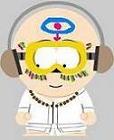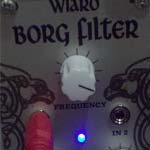| |
| Author
|
Been trying to dj, but still can match the beats!
|
Djones
IsraTrance Senior Member

Started Topics :
267
Posts :
1766
Posted : Nov 29, 2006 17:33
|
Hey thnx for all your tips!
I'm improving day by day.
But I wonder, let's say your playing a track but you wanna speed it up gradually.
Say going from 138 to 141 Bpm slowly, so after that you can mix in another track at 141 Bpm.
Is this done or not done?
|

|
|
xrust
IsraTrance Full Member

Started Topics :
63
Posts :
1742
Posted : Nov 29, 2006 23:40
|
it is preferable(IMO) not to take the track 3 bpms up.it would be better to take it at 139 while it plays(slowly and better not when there is a beat,try to do it in the cuts of the track) and pitch the next track 2 bpms down!though it may be not so good to get your set 3 bpms faster in two tracks,it would b better to do this slower!i usually begin my sets around 136 and taking it up to 140(most of the times  ) )
hope i helped 
        Signature: Signature:
|

|
|
Elad
Tsabeat/Sattel Battle

Started Topics :
158
Posts :
5306
Posted : Nov 30, 2006 01:07
|
some tips
i check my tracks in program like mixmeister or tracktor to check bpm , and write it down.
not must ,but helps heaps.
now i have track playing in player A , lets say 140 bpm.
the track on deck B is 142 bpm , and as we know in this tempo's 0.7 on the pitch counter =1 bpm.
so we take this one -1.4 .
now we know they supose to match
still not ey
good idea is to catch the "cue" point.
meening the point we want to start from , usualy not the 0:00 but 0:30 or whatever.
now we set the cue point we can start
when u feel its right (count 1234 1234) hit play
listen carefully to the beats and their match
when its not cool , play with jog (of B deck)
then it should be fine
micro tuning possible with jog as well

when its perfect raise the volume of channel play with bass and such
5cent i know
but i after 5 years got to level im pritty happy.
always can do better
otherwise we wont learn

        www.sattelbattle.com www.sattelbattle.com
http://yoavweinberg.weebly.com/ |

|
|
UnderTow

Started Topics :
9
Posts :
1448
Posted : Nov 30, 2006 03:58
|
I'll give a bit opposit advice than tsabeat: Don't make BPM lists. If you start to learn to mix without such a list, you will learn much faster to mix everything by ear. You will get a better feel for how fast the music is and what you can and can not mix with each other.
The longer you use a list or a BPM counter or anything like that, the longer it will take to get a real feel for the music. Also, they are just distractions when mixing. If you have to look up the BPM of a track in a list, you loose time when mixing in front of a crowd. If you do it by ear, you will be able to just listen to tracks an know where to fit them in your sets quite soon.
As others have mentioned, find the very first beat in a track and set your cue point there. Then listen to the track playing on your speakers and learn to hit the play button at exactly the right time so that the new track plays more or less in sync with the old track. Then fine-tune for a perfect match.
When the two kicks are perfectly in sync, the kicks will add up and will sound much bigger. If they a just very slightly off, they will phase cancel and sound thin. If they are more out of sync, you will hear two kicks. If they are much out of sync you will sound like Goa Gil.  Concentrate on the initial click of the kicks. They should be perfectly matched. This will take some time and practise. Concentrate on the initial click of the kicks. They should be perfectly matched. This will take some time and practise.
When you mix in a new track over the speakers, take out all the bass from the new track. You can then slowly increase the bass on the new track while removing the bass of the old track for a slow flowing mix or you can do what I usualy do: Slam dunk into the new track. Turn both bass EQ knobs at the same time in opposit directions at the right time. Or slowly take out the bass of the old track untill it is completely out and then slam the EQ open of the new track at the right time.
Also always!!! get the tracks synced measure wise. So launch new tracks on whole measures. (Usualy where the cymbal hits at the end of 8/16/32 bars). If you do that, the build ups and breaks will fit with each other. If you do this, not only will things sound right rythmicaly but you also won't get surprised by a break that you had forgotten about or anything like that.
UnderTow |

|
|
Dharma Lab

Started Topics :
8
Posts :
342
Posted : Nov 30, 2006 21:45
|
Quote:
|
On 2006-11-30 03:58, UnderTow wrote:
Also always!!! get the tracks synced measure wise. So launch new tracks on whole measures. (Usualy where the cymbal hits at the end of 8/16/32 bars). |
|
Hehe, that's what makes mixing psy-trance difficult sometimes, it's very structure occasionally leads it'self to off-beat breaks, pauses, etc. Such is the name of the game.
Large BPM changes are possible, but the more melodic the track, the more you'll notice the pitch change. Some CD decks have Key correction, which can really help with this. I will generally slow the cued track down more, and only bump up the pitch of the playing track a little. In general, I try not to change the pitch more than 2.1 during the course of a single track. That's just me though. I like my transitions & set flow to be smooth sounding (which doesn't always mean smooth mixing).
If you don't have key correction, make sure you pay attention to how the track sounds. Sometimes a slight change of .2 or .3 will change the pitch of the track to something that sounds more natural (i.e. not between keys).
        Keep The Faith, Keep The Faith,
Christian K. |

|
|
cytopia
Cytopia.org

Started Topics :
61
Posts :
329
Posted : Dec 2, 2006 14:23
|
The main thing that helped me, other than practicing alot, was to know my music, what I wanted to play, what fit with each other, where the breaks are in the tracks...
AND by ear setting pitch of track to be mixed in to near the one thats playing, then use wheel to get the kicks on top of each other, then as you hear them going off synch, its good to know if you need to speed up the track you want to mix in or slow down. Also, a pefectly set pitch should stay synchronised with other track forever, and you will in time learn to hear when kicks are exactly on top of each other....
But when a track is not perfect, during a mix you will hear the kicks start to drift, AND THEN it is really important to know whether to use wheel to nudge it forward, or backward just a bit to get it back in synch (wrong way sux).
Also can try while you raise level for track you are mixing in, decrease the bass EQ of the track that is playing... but that really depends on the tracks... relative EQ settings you can do interesting things...
Dont be in a hurry. Many people quit becuase they are impatient. My mixing sucked for months, its normal.... And i can even now only mix well if I am relaxed and inspired...

        Cytopia.org Cytopia.org
Psychedelic & Progressive Downloads
Mp3 / WAV CD Quality Downloads
Full Streamed Previews |

|
|
Djones
IsraTrance Senior Member

Started Topics :
267
Posts :
1766
Posted : Dec 4, 2006 15:00
|
I'm trying to figure out how to work with the cue button.
Say I'm trying to find the right cue point where the first kick starts.
But when I hear this short loop sounding like a woosh and kick after each other, I can noway tell wetter it's the kick or the woosh which comes in first!?
Well, I then think I have the cue set at the kick, but when I press play, it starts with the woosh before the kick.
Help is highly required!
Thanks! |

|
|
the dog of tears
the dog of tears

Started Topics :
9
Posts :
399
Posted : Dec 6, 2006 11:00
|
Okay finding the kick with the cue is like an ultra important starting point, IMO. When you hear the first kick of the first downbeat that you want your incoming track to start on, press pause. Scroll back with the jog wheel, you are now listening to the music in frames (75 frames a second), basically dividing up little audio increments. Find the transient of the kick drum. Scroll over it with the jog wheel. Listen to it... it is very distinct. Now jog backwards slowly, listening to the kick drums transient frame by frame. When you hear the very FIRST frame of the transient, jog one frame behind that and hit play/pause or cue (however your cdj works to assign a cue point)... you now have the ultimate ninja weapon cue point on your side!
Now for me all i do at this point is count the music playing over the speakers 1 2 3 4 and at a nice down beat launch my cue track... make a nice first guess on correction... then repeat, and make corrections from there. I keep restarting from the cue point and make percentile amount adjustments based on how many bars the two tracks stay in sync for. So if it stays in for a while, like 30 or 40 or 45 seconds but then starts to slip, i know it's an adjustment of .1 or .2... but shorter, 4 bars or 8 bars or 16, maybe .4 to .6, etc. It's all practice. Any ways i don't fuck with the shit at ALL while it's playing. I just keep restarting from my cue point with new adjustments. once i have it perfect which takes 60-90 seconds, i start mixing it in the head phones, figuring out what kind of eqing might sound nice, which of course is the actual difficult part... mostly cus you can't eq the track playing (at least not without pissing off the so called audience... i do this alone or w/ casual friends)... and also difficult because you can sit there and do it forever and then all of the sudden you realize you gotta throw the mix out there!
oh one more hint is... sometimes the downbeat of the track you wanna cue starts with some nutty trancey bass drum roll, and the transients bleed, so oops! you can't find your cue point so easily... try jogging to the next kick drum and literally counting the amount of individual frames in that kick drum. then you now exactly how long the kick drums transient of the track is... usually around 12-14 frames... go to the downbeat kick and count it to the frame. voila... takes a second... practice makes perfect.
good luck... |

|
|
|
|